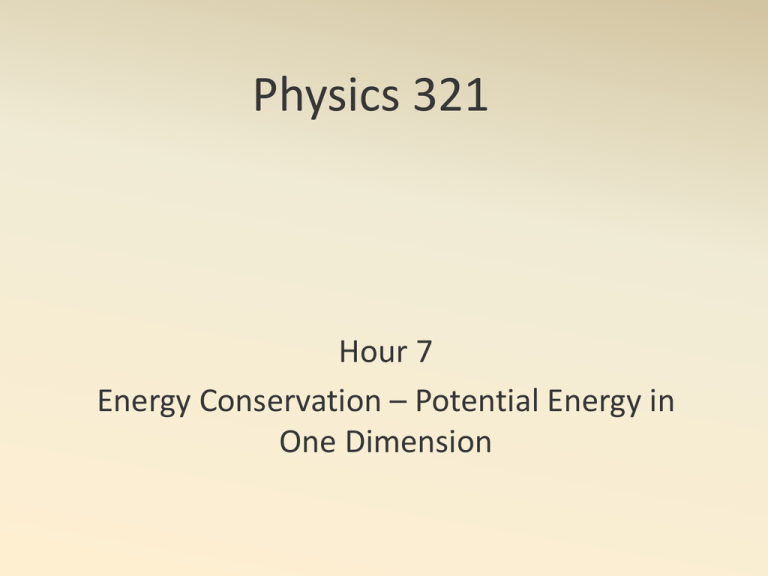Physics 321 Hour 7 Energy Conservation – Potential Energy in One Dimension
advertisement

Physics 321 Hour 7 Energy Conservation – Potential Energy in One Dimension Bottom Line • Energy is conserved. • Kinetic energy is a definite concept. • If we can determine the kinetic energy at all points in space by knowing it at one point in space, we can invent a potential energy so that energy can be conserved. • Kinetic energy is related to work. • Potential energy must also be related to work. Kinetic Energy 1 𝑇 = 𝑚𝑣 2 2 1 𝑃 = 𝑇 = 𝑚2𝑣 𝑣 = 𝐹𝑣 2 Does that make sense? Is it sometimes true? Is it always true? Work-Energy Theorem 1 𝑝∙𝑝 𝑇 = 𝑚𝑣 ∙ 𝑣 = 2 2𝑚 𝑝∙𝑝 𝑝∙𝑝 𝑝∙𝑝 𝑃=𝑇= + = =𝐹∙𝑣 2𝑚 2𝑚 𝑚 This is a useful relation – but we’ll go one step further: 𝐹 ∙ ∆𝑟 ∆𝑇 = ∆𝑡 → 𝑑𝑇 = 𝐹 ∙ 𝑑 𝑟 ∆𝑡 2 ∆𝑇|21 = 𝐹 ∙ 𝑑 𝑟 = 𝑊1→2 1 • Positive work increases kinetic energy, negative work decreases kinetic energy Gravity Depending on initial velocity, an object can move freely under the influence of gravity in many different paths from 1 to 2. y 1 2 In each case: 2 𝑊= 2 𝐹 ∙ 𝑑𝑟 = 1 2 𝐹𝑦 𝑑𝑦 = −𝑚𝑔 1 = −𝑚𝑔 𝑦2 − 𝑦1 = −𝑚𝑔∆𝑦 And on any closed path 𝑊 = 𝐹 ∙ 𝑑 𝑟=0 𝑑𝑦 1 x Gravity y 1 This means that ∆𝑇 from 1 to 2 is independent of path. If we know 𝑇1 we also know 𝑇2 . 2 x Potential Energy If ∆T is dependent only on the end points of a path (not on the path or on time), we can define a potential energy. Otherwise, we can not. 𝑊= y 1 𝐹 ∙ 𝑑 𝑟 = −𝑚𝑔∆𝑦 = −∆𝑈 2 x Stokes’ Theorem I P1 y 𝐹 ∙ 𝑑𝑟 = 𝑃1 𝐹 ∙ 𝑑𝑟 + 𝑃2 𝐹 ∙ 𝑑𝑟 𝑃3 P3 P2 Note the path integrals on the mid-line cancel. 𝐹 ∙ 𝑑𝑟 = 𝑃1 x 𝐹 ∙ 𝑑𝑟 𝑖 𝑃𝑖 Pi P1 Stokes’ Theorem II y 𝐹 ∙ 𝑑𝑟 = 𝐹 ∙ 𝑑𝑟 𝑃1 = 𝑖 = 1 ∆𝐴𝑖 𝐹 ∙ 𝑑 𝑟 ∆𝐴𝑖 𝑃𝑖 1 lim ∆𝐴→0 ∆𝐴 𝐹 ∙ 𝑑𝑟 = 𝑃1 𝑃𝑖 𝑖 𝐹 ∙ 𝑑𝑟 𝑑𝐴 𝑃 𝑐𝑢𝑟𝑙 𝐹 ∙ 𝑑 𝐴 Pi P1 x Potential Energy If the curl of 𝐹 is zero and 𝐹 has no explicit time dependence, we can define a potential energy. Otherwise, we can not. In general, if 𝑈 = − 𝐹 ∙ 𝑑 𝑟, 𝐹 = −𝛻𝑈. Since 𝛻 × (𝛻𝑈) ≡ 0 the curl of 𝐹 must be zero. Differential Form of the Curl 𝑐𝑢𝑟𝑙 𝐹 𝑧 = 𝐹𝑦 𝑥 + ∆𝑥, 𝑦 − 𝐹𝑦 𝑥, 𝑦 ∆𝑦 − ∆𝑥∆𝑦 𝐹𝑥 𝑥, 𝑦 + ∆𝑦 − 𝐹𝑥 𝑥, 𝑦 ∆𝑥 ∆𝑥∆𝑦 𝜕𝐹𝑦 𝜕𝐹𝑥 = − 𝜕𝑥 𝜕𝑦 𝑥 𝛻 × 𝐴 = 𝜕/𝜕𝑥 𝐴𝑥 𝑦 𝜕/𝜕𝑦 𝐴𝑦 𝑧 𝜕/𝜕𝑧 𝐴𝑧 y+Δy y x x+Δx Spherical Coordinates It’s important to go back and forth between spherical and Cartesian coordinates. Know these: 𝑥 = 𝑟 sin 𝜗 cos 𝜑 𝑦 = 𝑟 sin 𝜗 sin 𝜑 𝑧 = 𝑟 cos 𝜗 𝑟2 = 𝑥2 + 𝑦2 + 𝑧2 𝑦 tan 𝜑 = 𝑥 𝑥2 + 𝑦2 tan 𝜗 = 𝑧 Cylindrical Coordinates It’s also important to go back and forth between cylindrical and Cartesian coordinates. Know these: 𝑥 = 𝑟 cos 𝜗 𝑦 = 𝑟 sin 𝜗 𝑧=𝑧 𝑟2 = 𝑥2 + 𝑦2 𝑦 tan 𝜑 = 𝑥 Vector Calculus in Mathematica vec_calc_ex.nb



